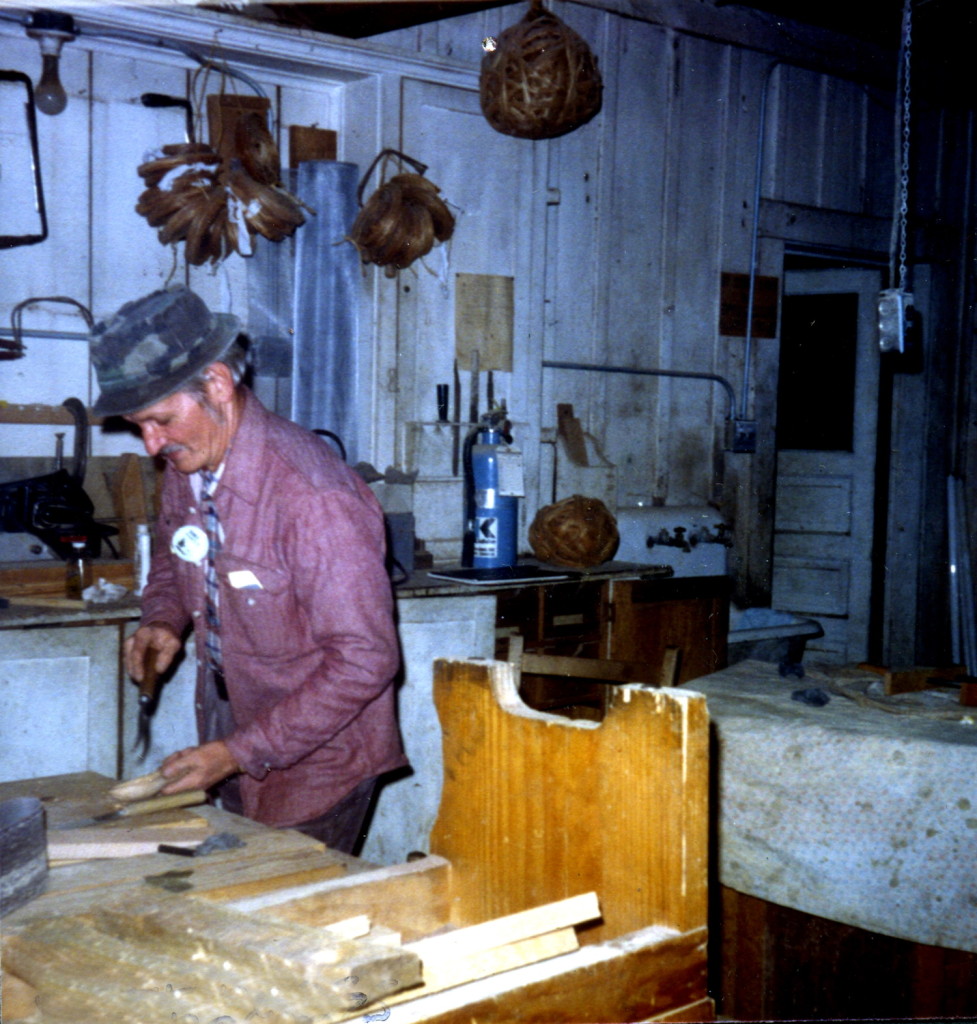Pine Mountain Settlement School
Series 35: OBJECT COLLECTIONS
Object Collections
Overview

Matt Boggs, staff member in woodworking shop, creating a wooden spoon and other items for someone’s object collection. [X_100_workers_2664_mod.jpg]
TAGS: object collections at PMSS, challenges of organizing and cataloging, Search Engine Optimization, Pine Mountain Settlement School Collections
OBJECT COLLECTIONS Overview
The collections at Pine Mountain are not just archives and books. In fact the School is one large “COLLECTION” — one large ARCHIVE. Cumulatively, Archive Pine Mountain Settlement School Collections, holds the history and the story of this 100+ year experiment in education. It is the archival record, largely documents and photographs, but it is so much more.
In all the buildings there are items that are objects that often appear in our own inventories of homes or businesses. These objects may include paintings, ceramics, desks, chairs, kitchen ware, weavings, quilts, linoleum block prints, old farm tools, woodworking implements, etc. Many of these objects were created by local craftspersons, such as the woodwork and many weavings. Many were donated by visitors, staff, and craft workshops. Further, many were created by a variety of commercial businesses.
This aggregate collection of objects is difficult to maintain, but it is even harder to organize. The first step in good stewardship is maintenance of an inventory of the many interesting and “teachable” objects found at the School. To use the many objects and make them valuable tools in the educational mission of the institution is sometimes daunting. It helps to aggregate, to bring like objects together.
However, some object collections obviously do not fit easily together within OBJECT COLLECTIONS. For example, books have their own category and inventory. Pamphlets, newspaper articles, and other ephemera often do not sit well within archives. Further, some OBJECT COLLECTIONS may now be only virtual (not a physical item) and have been assembled to create an aggregate of examples that may be used for instruction. Corn-husk dolls and mats, and old farm tools not currently in use, but also not on-site, are groups of OBJECT COLLECTIONS found in our archive that do not lend themselves to easy categories.
Making decisions about how to organize objects is a science and various cataloging rules have been developed to address a variety of similar objects. (See Chenault collections, which have their own rules.) Museum items have their own standard cataloging demands. Unfortunately, the “cataloging systems” used to address the organization of objects do not always talk to one another. Schema, or schemes for organizing, sometimes do not last or go out of favor, making the process of building an index difficult. The one nemesis in cataloging collections, is SIZE. The larger the COLLECTIONS, the greater the urge to increase the kinds of collections and common sense seems to fall away.
All these challenges are still at work in the far-reaching technical world we all share and supposedly can use to rapidly build collections of things. Today the language, what is now sometimes pulled together under the rubric of “SEO”, or Search Engine Optimization, is used a lot. This means that a large collection of disparate material is “optimized” for the users and enables the user to search and find relevant requests through a “search engine optimization” process.
In simple terms, SEO means the process of improving your site to increase its visibility for relevant searches. In the computer world it is a horse race and most often driven by the need to sell you something. The better visibility your pages have in search results, the more likely you are to garner attention and attract prospective and existing customers to your “business.” Education often is a sideline.
On this web site we try to keep pace, but sometimes we err and sometimes we fail miserably, and sometimes we are amazingly surprised at responses. It makes creating and using a large web site difficult, but sometimes exhilarating.
All this said, this is an evolving story… an evolving history. OBJECT COLLECTIONS will most likely be the most shape-shifting part of this journey of bringing the history of the institution forward.
SEE:
OBJECT COLLECTIONS Guns, Rifles, Sword, and Andy’s Gun Story
OBJECT COLLECTIONS Inventory by Building
OBJECT COLLECTIONS Weaving Draper Loom Studio

